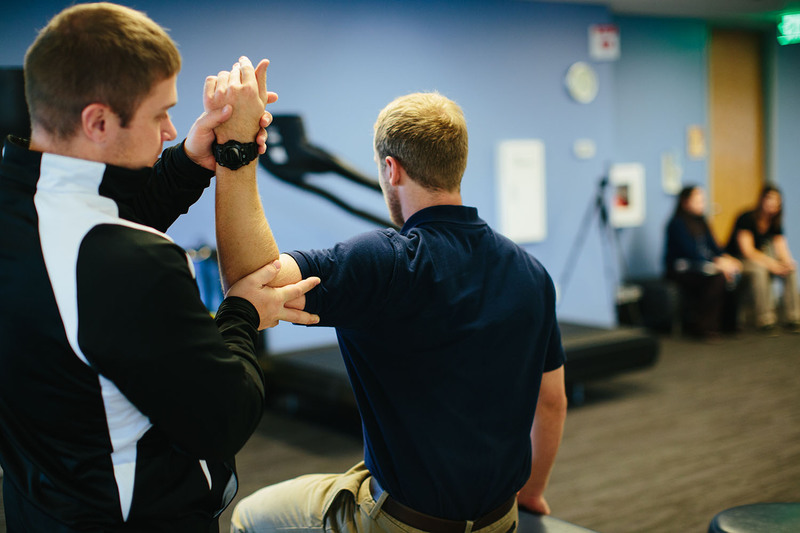
The Effect of Clavicle Shortening on 3D Shoulder Motion
Clavicle fractures are quite common, accounting for 2.6 – 5 percent of all fractures. Seventy to 80 percent of clavicle fractures involve the middle third of the clavicle and 48 percent of these fractures are displaced. Most clavicle fractures occur in active younger individuals as the result of high-energy mechanisms, including falls from a height, falls during
sports such as cycling, skiing and snowboarding, and motor vehicle collisions.
The mechanism of injury is a direct blow to the superolateral shoulder. The intact clavicle is the only bony attachment of the upper extremity to the axial skeleton (chest). It acts as a strut, maintaining both scapular position and the length tension relationships of the muscles originating on the thorax and inserting on the scapula and humerus. Loss or alteration of this strut is thought to negatively affect shoulder function but has not been definitively determined. When treated nonoperatively, most displaced clavicle fractures heal with some degree of deformity, typically shortening with superior displacement of the medial fragment. The weight of the arm and pull of the pectoralis major on the lateral fragment and the upward pull of the sternocleidomastoid on the medial fragment are suspected causes of this deformity. The predictable malunion that follows alters the resting position of the scapula to one of protraction and downward rotation. The effect of this altered set-point of the scapula is thought to cause aberrant scapular movement during functional activities, leading to pain, fatigue, loss of strength, and possibly subacromial impingement. However, the functional capabilities and potential deficits of the acromioclavicular and glenohumeral joints due to loss of clavicle length have not been described or quantified.
Most non-displaced and minimally displaced clavicle fractures are successfully treated nonoperatively with excellent union rates with outcomes well described. However, controversy still exists regarding operative indications for more displaced middle-third clavicle fractures. Recently, several studies evaluating nonoperative treatment using patient-based outcome tools have reported less favorable results than similar studies done in the 1960s. In 2007, a randomized controlled trial of 111 displaced mid-third fractures randomized to open reduction and internal fixation versus nonoperative treatment found improved outcome scores, time to union, and union rates in the open reduction and internal fixation group at one year. A 2006 retrospective study of 132 patients with clavicle fracture treated with resultant union showed that 25 percent of the patients were dissatisfied at 30-month follow-up, and the dissatisfaction correlated with clavicular shortening of 18mm in men and 14mm in women. In a 1997 study of 52 displaced middle-third clavicle fractures treated nonoperatively, 31 percent of patients reported an unsatisfactory result and there was a 15 percent nonunion rate. The body of knowledge regarding orthopaedic management of displaced midshaft clavicle fractures is evolving.
Clavicle malunion is not well defined in the literature and although most authors suggest that over 15mm of shortening is malunion, angular and rotational malalignment have not been used to define clavicle malunion. Studies have shown that patients with clavicle malunion experience pain, weakness or fatigability, neurologic symptoms, and cosmetic deformity, despite having full shoulder range of motion and strength on manual muscle testing. Many other patients with clavicle malunion are asymptomatic. Unfortunately, physical examination techniques can’t reliably identify which patients have disability due to shoulder dysfunction from clavicle malunion. This is likely due to the fact that the complex three-dimensional motions of the clavicle and scapula are difficult to evaluate because the overlying muscle and skin obscure surface landmarks and there is no lever arm to help quantify scapular movements. Alteration of the strut function of the clavicle and of the length tension relationships of the periscapular and shoulder musculature could help explain the symptoms experienced by those with clavicle malunion. Currently, no study has been conducted that links basic science or biomechanical data to the problems associated with malunion or the improved patient-based outcomes seen with reduction and internal fixation of displaced clavicle fractures.
The purpose of this study is to evaluate and quantify the functional capabilities and potential deficits of the acromioclavicular and glenohumeral joints due to loss of clavicle length compared to the unaffected, opposite side during active motions.
Specifically, we will determine relationship changes in the acromioclavicular and glenohumeral joints due to loss of clavicle length and estimate linear translations of the humeral head relative to the glenoid to characterize the migration of the humeral head. Additionally, minimum linear distances between the humeral head and the coracoid and acromion will be calculated to investigate impingement which may result from the alterations in acromioclavicular and/or glenohumeral joint movement changes.
By identifying these changes and differences based on the function and shortening of the clavicle length, we hope to identify potentially deleterious changes in shoulder function that have not been previously identified, improve treatment and decision-making for clinicians treating patients with clavicle fractures, and provide prognostic recommendations for patient care when malunions and clavicle shortening do occur.

